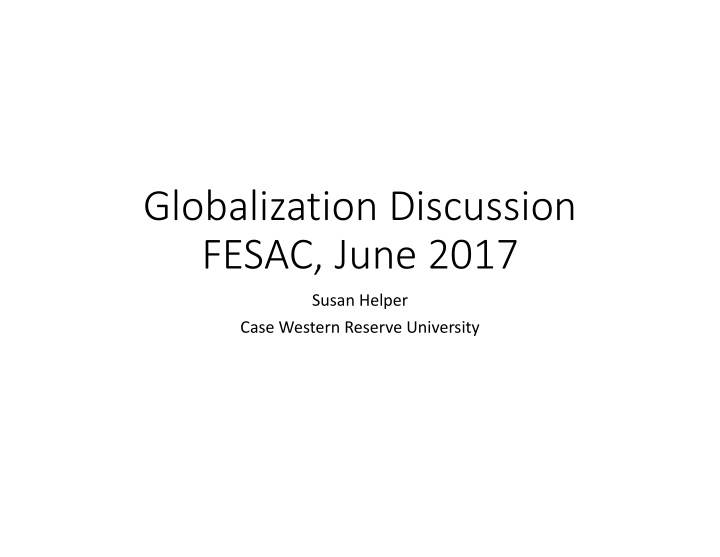



Globalization Discussion FESAC, June 2017 Susan Helper Case Western Reserve University
Introduction • Great advances in globalization discussion • TIVA • Exploration of heterogeneity • Integration of international and labor economics • Integration of international and industrial organization • Thoughts on role of supply chains in global and domestic production • FGP • Heterogeneity in responses across industries and functions • Thoughts on integration of microdata and case study work
Howells • TIVA has changed our understanding of sources of trade deficit, nature of competition and cooperation in world economy • Competition from high ‐ wage countries (not just China) • Work on firm heterogeneity shows that one size does not fit all
Jensen/Kamal • “Globally ‐ engaged” firms play a key role in the economy • Exporters create more jobs and are less volatile • LFTTD data offers potential for better understanding of firm activity (not just establishments)
Grimm/Kim • This paper focuses on the relationship between trade and the nature of jobs (not just their quantity) • In general, US MNE foreign activity is positively correlated with domestic activity
Varian • Non ‐ market and free goods play a key role in economic activity and welfare • Much new econ activity has near ‐ zero marginal cost production functions (Varian and Shapiro, 1999) • Impacts on input ‐ output tables? • Firms are unbundling and recombining activities and locations
What is driving the trends we see? • Role of global value chains • Definition: network of firms involved in designing, producing inputs for, assembling, and distributing a good or service. • Include long ‐ term relationships as well as vertical integration and arm’s ‐ length transactions • Rise of GVC’s makes relationships between firms more important. • In contrast, most data collection focuses on what happens within an enterprise, or more commonly, within a single establishment. • Papers highlight some key trends: • Unbundling of firm functions (eg, FGP) • Heterogeneity in firms’ globalization strategies
FGP approach • Fragmentation of tasks exists • Define a particular kind of fragmentation • Argue that even though these producers do no manufacturing, they should be classified as manufacturers
FGP definition • Factoryless Goods Producers (FGPs) are establishments that: • Do not perform manufacturing transformational activities, but… • Own the design or intellectual property of a product, and • Control the production process
Product Developm ent Process for Custom er’s Current Model Case W estern Reserve University Survey of Auto Suppliers, 2 0 1 1 – Percent Saying Yes – 1. Customer took entire responsibility 33% 2. Customer provided majority of engineering hours; your 29% business unit provided the rest 3. Customer and your business unit contributed equally to 16% the design 4. Your business unit provided majority of engineering 28% hours 5. Your business unit took entire responsibility 16% 6. Collaborated with the customer to specify component interfaces or to design related components of the 41% customer's product 0% 10% 20% 30% 40% 50%
FGP issues • The FGP concept privileges “owning” over “doing” • Combines firms that do design with those that own designs • Solves some consistency problems, but creates others • Occupational distributions • Employment content of exports, imports • Is a small (and probably diminishing) form of fragmentation
Alternative approach to understanding reconfiguration of tasks in global production • Pilot projects to explore how fragmentation actually occurs in a variety of industries • Continue focus on what establishments/firms do, as opposed to focus on what they own • Examine how ties between firms actually work • More than price information crosses firm boundaries • Importance of “relational contracts”
Focus on 2 ‐ 3 industries • Hotels • Manufacturing • Cleaning • Component production • Reservations • Product design • Front desk • R&D • Legal • Equipment design • Strategy • Equipment maintenance • Assembly
Implications of firm heterogeneity • Draw on “industry studies” approach • Researchers that draw on deep engagement with a particular industry • Does globalization lead to more efficient division of labor or hollowing out of capabilities? • Grimm/Kim: support for “efficient division of labor” • Pisano/Shih: using electronics case, argue for “hollowing out” • Offshoring progressive loss of assembly, component mfg, design, innovation capabilities • Could we reconcile?: • Include employment in domestic supply chains as well as at focal MNC • Longitudinal research • Causation as well as correlation • Consider complementarities in firm strategies • Look at discrete as well as continuous cases • Perhaps trade differently with high ‐ wage countries
Benefits of industry studies focus • Understand heterogeneous responses • Improved matching • Understand relationship between enterprise and establishments • Generate theory than can motivate future data collection • Unbundling • Ask directly about firm practices (MOPS) • Stories that help users • Eg, economic development /training agencies within states • Creates confidentiality issues—could be managed
Conclusion • Great advances in globalization discussion • TIVA • Exploration of heterogeneity • Integration of international and labor economics • Integration of international and industrial organization • Thoughts on role of supply chains in global and domestic production • FGP • Heterogeneity in responses across industries and functions • Thoughts on integration of microdata and case study work
Recommend
More recommend